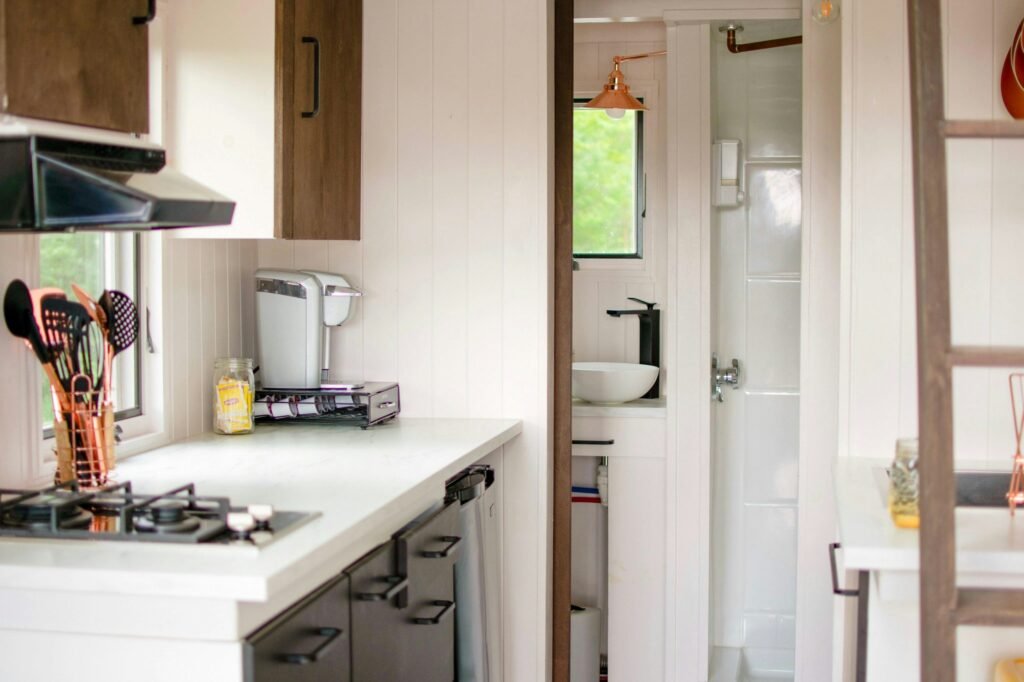Discover the essentials of maintaining a net-zero home to ensure energy efficiency and sustainability. Learn about solar panel care, water conservation, smart technology, and more for a net-zero lifestyle.

Photo by Bill Mead @ Unsplash.
Dive into a world where harmony with nature isn’t just a dream but a living reality. A net-zero home embodies the pinnacle of sustainable living, where every element, from the energy it produces to the water it conserves, aligns with the earth’s rhythms.
The key to maintaining these eco-friendly homes at peak performances is ongoing upkeep. This guide unwraps the essentials for ensuring your net-zero home remains an efficient and sustainable haven for years to come.
Introduction to Net-Zero Home Maintenance: The Foundation of Sustainable Living
Net-zero homes, the epitome of sustainable architecture, require a nuanced approach to upkeep that aligns with their eco-friendly ethos, ensuring that the delicate balance of energy independence is never compromised.
The importance of routine maintenance in such homes cannot be overstated. It is the cornerstone upon which the promise of energy efficiency and sustainability rests. Regularly attending to common maintenance areas ensures that the systems and processes crucial to the net-zero lifestyle operate optimally, keeping the dream of sustainable living vibrant and viable.
Solar Energy Systems Maintenance for Longevity
The energy system in a net-zero home, often relying heavily on solar panels and sometimes wind turbines, forms the backbone of its sustainability efforts. These systems are ingeniously designed to capture and convert natural resources into usable energy, but their efficacy heavily depends on regular maintenance.
The accumulation of dust and debris on solar panels, for instance, can significantly reduce their efficiency, underscoring the need for regular checking and cleaning.
Moreover, energy storage systems, like batteries, are pivotal in managing the excess energy generated. These systems ensure that power is available when the sun sets or the wind doesn’t blow. Regular maintenance of these storage units not only prolongs their life but also ensures that they function efficiently, maintaining the home’s energy self-sufficiency.
Water Conservation Systems Upkeep
Additionally, water, the lifeblood of any home, assumes even greater significance in a net-zero home. Systems like rainwater harvesting are installed to reduce reliance on municipal water supplies by capturing and utilizing rainwater for various household needs.
The care of these systems, including periodic cleaning of catchment areas and checking for blockages in conveyance systems, is critical to their continued efficiency.
Simultaneously, water-efficient appliances and fixtures, such as low-flow toilets and showerheads, contribute significantly to reducing water consumption. These technologies demand regular checks to ensure they operate at peak efficiency.
Addressing leaks promptly and optimizing water usage through behavioral changes are also vital components of maintaining a water-wise net-zero home.
Insulation and Ventilation Vitality
Maintaining the integrity of a home’s insulation is also crucial for minimizing energy loss and ensuring that heating and cooling efforts are efficient. Insulation materials need to be inspected regularly for signs of dampness or damage which can compromise their performance.
On the other hand, ensuring proper ventilation is equally important for maintaining air quality and removing unwanted humidity or pollutants from the home, necessitating seasonal checks and adjustments to these systems.
The synergy between insulation and ventilation systems is a fine balance in a net-zero home, requiring regular maintenance to adapt to the changing seasons. These systems not only support the home’s energy efficiency but also contribute significantly to the comfort and health of its inhabitants, making their upkeep a necessary investment in a net-zero lifestyle.
Smart Home Technology and Appliances
Likewise, the integration of smart home technology and energy-efficient appliances is a hallmark of modern net-zero homes, offering unprecedented control over energy consumption and environmental impact.
Regular updates and troubleshooting of smart home systems are indispensable for maintaining their efficiency and ensuring that they continue to contribute positively to the home’s net-zero balance.
Routine checks of energy-efficient appliances also play a critical role in upholding the home’s sustainability goals. These appliances, designed to use less energy for the same performance as their conventional counterparts, need regular servicing to keep them operating at their best. Staying informed about new sustainable technologies further empowers homeowners to keep their net-zero homes at the forefront of eco-friendly living.
Indoor and Outdoor Environmental Quality
When it comes to air quality, preserving it is a fundamental aspect of living in a net-zero home, with natural methods like adding indoor plants and strategically placed air-purifying systems playing a pivotal role.
Incorporating indoor plants and eco-friendly landscaping into net-zero homes not only enhances aesthetic appeal but also significantly improves indoor and outdoor air quality. Plants like the Chinese Evergreen and Azalea can thrive in low-light and cool conditions, respectively, purifying the air by removing harmful pollutants like formaldehyde and xylene.
The Red-Edged Dracaena, with its visually striking purple-red edges, is another excellent choice, capable of filtering out toxins introduced through household products. Beyond individual plants, the integration of air-purifying species such as the Areca Palm, Peace Lily, and Snake Plant into home design contributes to a healthier living environment by filtering out a wide range of chemicals and improving overall air quality.
These examples underscore the practical benefits of incorporating greenery into homes, proving that simple, natural solutions can play a pivotal role in achieving and maintaining net-zero living standards.
Conversely, the maintenance of outdoor spaces through eco-friendly landscaping and the use of non-toxic, sustainable cleaning products reinforces the home’s commitment to environmental stewardship, enhancing both its aesthetic appeal and its ecological footprint.
The attention to both indoor and outdoor environmental quality not only supports a net-zero lifestyle but also contributes to the overall well-being of the residents. By employing sustainable maintenance practices, homeowners can ensure that their living spaces remain healthy, vibrant, and in perfect harmony with nature.
Engagement and Continuous Learning
Living in a net-zero home extends beyond the confines of individual properties, often inspiring a broader engagement with community initiatives aimed at promoting sustainable living. By participating in these initiatives and continuously learning about and implementing sustainable practices, homeowners can contribute to a larger movement toward environmental stewardship.
Furthermore, sharing experiences and tips with other net-zero homeowners fosters a sense of community and collective learning. This exchange of knowledge not only enriches the individual experience of net-zero living but also accelerates the adoption of sustainable practices in the wider community, demonstrating the transformative power of collective action in pursuit of a sustainable future.
The Municipality-led Initiative in Edmonton
The Blatchford project in Edmonton is a municipally-led initiative aimed at developing a carbon-neutral community. Despite facing challenges related to the housing market and economic uncertainties, the project’s long-term vision allows for adaptability over its 20-25 year development period.
This community is guided by a comprehensive plan that includes sustainable technologies and practices, demonstrating the importance of perseverance and adaptability in achieving net-zero living.
The Co-Housing Community in Portland, Oregon
Ankeny Row in Portland, Oregon, is a co-housing community designed for retiring couples with a strong desire to live sustainably in the city. Developed on a quarter-acre brownfield site, it features six townhomes and shared amenities like a common room and courtyard, promoting social cohesion among residents.
Emphasizing sustainable urbanism, Ankeny Row integrates features like a super-insulated Passive House envelope and rooftop solar panels, achieving net-zero energy consumption. This project showcases how community-driven initiatives can successfully combine environmental sustainability with a high quality of urban life.
Ignite Your Net-Zero Journey: Embrace Maintenance as Your Catalyst for Change
Maintaining a net-zero home is more than a checklist; it’s a commitment to a lifestyle deeply rooted in sustainability, efficiency, and community. By prioritizing regular maintenance and continual learning, the dream of a net-zero lifestyle transforms into reality, paving the way for a future where sustainable architecture is the norm, not the exception.
BillionBricks builds net-zero homes that are energy-efficient, self-sustaining, and affordable. If you have a project in mind or would like to use our home designs, we would love to hear about it and explore ways to work together. You may contact us here.
If you’re interested in further net-zero home exploration, check out another article that provides additional insights. Read Davao’s Progress Toward Net-Zero Living and Sustainable Housing.
Resources:
-
Princess Catherine Pabellano. BillionBricks Net-Zero Homes as Models for Sustainable Living. Retrieved from https://billionbricks.org/updates/billionbricks-net-zero-homes-as-models-for-sustainable-living?rq=net%20zero%20homes
-
Princess Catherine Pabellano. Top 5 Sustainable Materials for Net-Zero Homes. Retrieved from https://billionbricks.org/updates/top-5-sustainable-materials-for-net-zero-homes?rq=net%20zero%20homes
-
Water Cache 101. Rainwater Harvestig 101. Retrieved from https://www.watercache.com/education/rainwater-harvesting-101
-
Sean Ronnie Hill. The Road Less Travelled: Reimagining the Architecture Industry for a Net-Zero Future. Retrieved from https://risedesignstudio.co.uk/blog/index.php/category/carbon-zero-homes/
-
Dr. John Gore. Technology Integration in Homes: The Smart Home Revolution. Retrieved from https://www.linkedin.com/pulse/technology-integration-homes-smart-home-revolution-eq8nc?trk=article-ssr-frontend-pulse_more-articles_related-content-card



